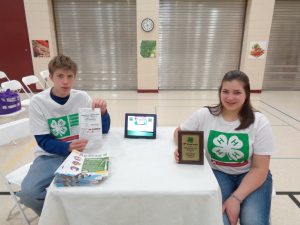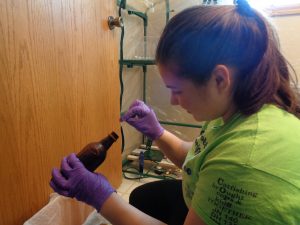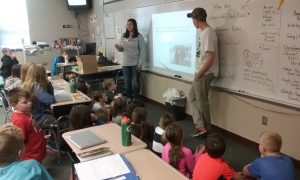
Anna and Tyler were at the Lonsdale Expo talking about their Minnesota 4H Science of Agriculture Challenge project.
Written by Jonathan Eisenthal
What fires up a kid’s curiosity?
What transforms a student into a lifelong learner?
Turns out it can be the same experiences that mold a young person into a “marketable, competitive job seeker, who can find a place in the agriculture sector — there are 60,000 jobs a year that need to be filled,” says Joshua Rice, the Science of Agriculture specialist with the Minnesota Extension Center for Youth Development.
Minnesota 4H has set up a program, unique in the nation, called Minnesota 4H Science of Agriculture Challenge. Students form teams and go out into their local community to talk to farmers and agribusiness leaders to determine an agricultural problem facing their community. The students then go to work with mentors, and use their growing skills in STEM — science, technology, engineering and mathematics — to create a potential solution.
From June 21-23, 15 4H teams, comprising 60 students from sixth grade through freshman year of college, will take part in the culmination of the Challenge. They will present projects to a panel of judges. These projects solved issues ranging from finding stray cattle by using GPS-enabled eartags, to reducing nitrogen loss from farm fields through the ideal plantings and designs of vegetative buffers, to transforming food waste into an energy source. The top three teams will be awarded scholarships to help them continue their studies.

Here is Anna prepping bottles for her Minnesota 4H Science of Agriculture Challenge project.
The Minnesota Corn Growers Association is a proud sponsor of the Challenge and will also participate in the judging.
Videos of these imaginative and innovative projects can be viewed at the Challenge web page
Food waste to energy
Brother and sister Brian and Anna Prchal of LeSueur, joined by their cousin Tyler of Hopkins, did a range of experiments arising out of the use of food waste as a component in processes that create energy and raise more food.
They used school food waste in two ways: combining different feedstocks like apples or bananas with cow manure to see which mixture produced the most methane, which is a gas burned for energy (apples ended up producing the most). They also mixed food waste with sawdust and manufactured briquettes from it. Using a calorimenter they built themselves, they measured which briquette offered the most energy when burned.
As part of the process of developing their project, Brian, Anna and Tyler toured Hometown BioEnergy, a power generation facility that takes in agricultural waste and waste from a local processed food facility and runs it through an anaerobic digester to produce biogas and generate electricity. Once the feedstock has been depleted (about 40 days in the tank), it can be used as a nutrient-rich fertilizer. The LeSueur team grew plots of corn and switchgrass to compare the yield from different rates of this fertilizer.
Teaching something new
“Hometown BioEnergy was really neat for me, because I am going to school for mechanical engineering,” said Brian, who just finished his freshman year at South Dakota State University. “Seeing huge cranes moving materials from bin to bin and seeing how the agitating and heating processes worked, I was watching all that. The factory tour was definitely one of the highlights this year.”
Anna, a rising sophomore at New Prague High School interested in veterinary medicine, loves communicating about agriculture to people in her community.
“It’s really cool how there are these things that people deal with every day — throwing away their food, for instance — and they don’t know what happens to the food waste, or how it can be used,” she said. “So we can come in and teach them something new.”

Brian and Anna talking to school children about their Minnesota 4H Science of Agriculture Challenge project.
Going national?
Rice hopes other states begin their own Science of Agriculture Challenge programs, and that eventually, there could be a national competition. He says that when he was a kid he would have loved to take part in a program like this.
“I grew up in 4H in West Virginia and participated in the program for 12 years,” said Rice, who was a high school agriculture teacher prior to becoming the director of the Challenge. “I participated in all the 4H public speaking events when I was a child and if this opportunity would have been presented, I definitely would have participated and I know my parents would have encouraged me to participate too. That college scholarship money would have come in handy.”
MCGA funded the scholarships and the luncheon on the final day of the program. Other supporters include American Crystal Sugar, AgStar Financial Services, Jenny-O Turkey stores, Pentair and Rahr Corporation.

